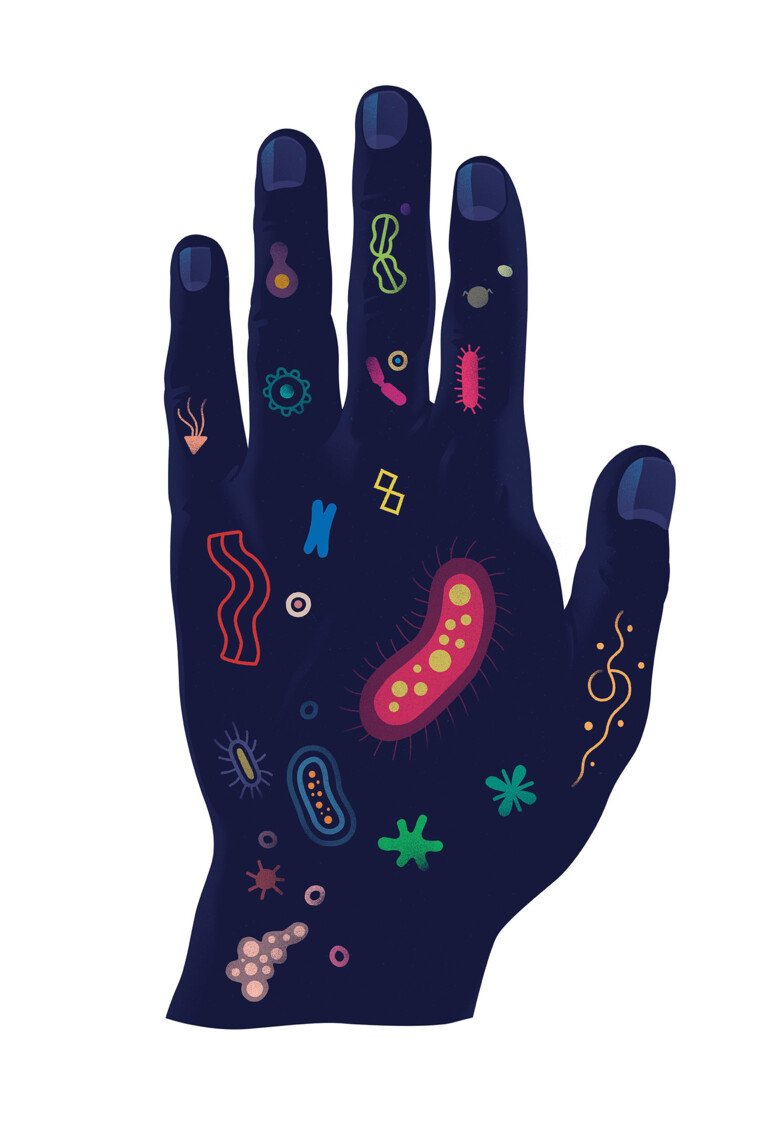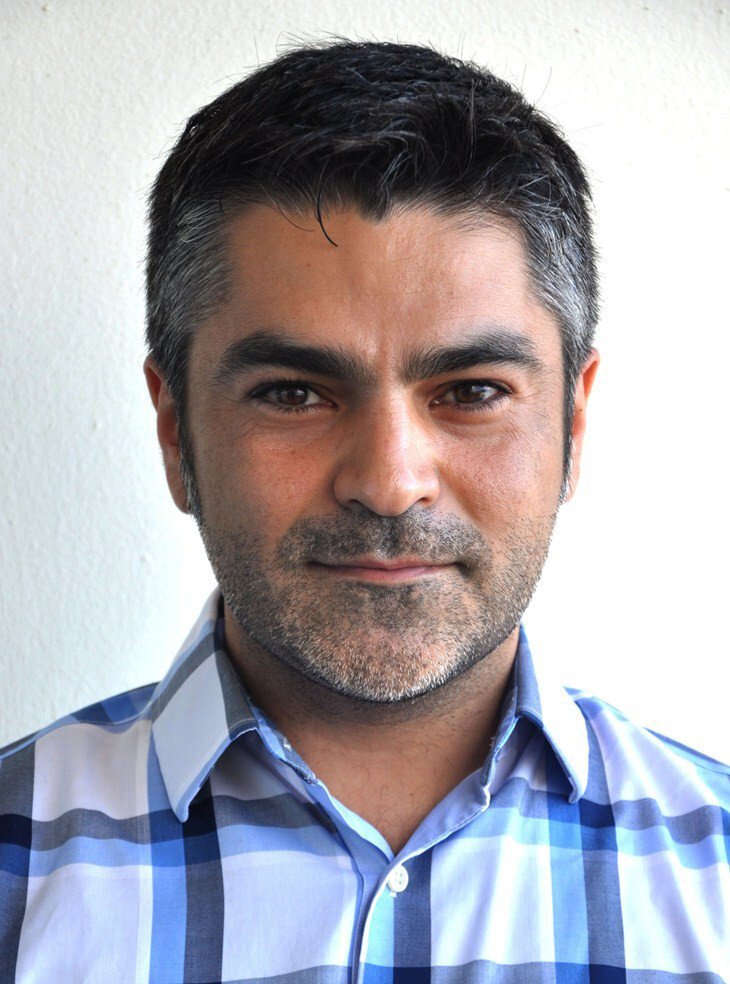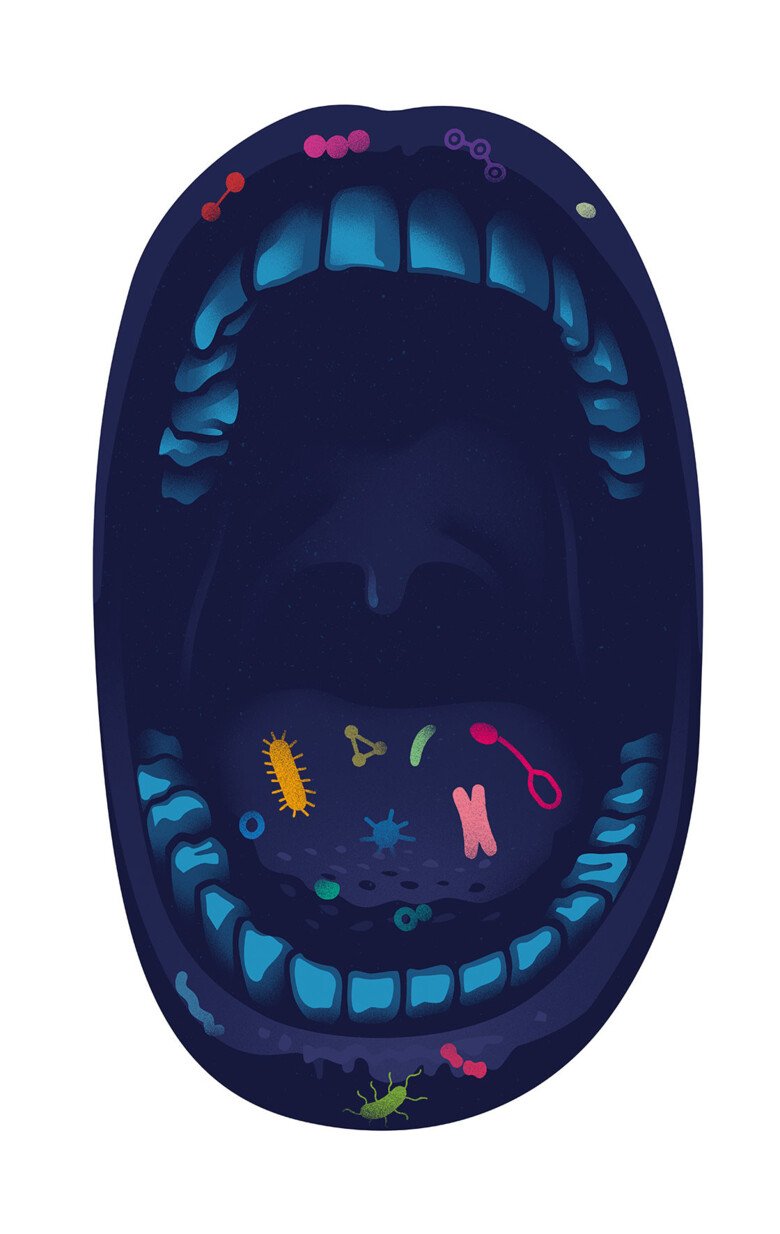Good bacteria: Diversity rather than simplicity
Lots of bacteria live on and inside our body. We would quickly get ill without them. But precisely how do they affect our health? One thing seems to be clear: Having varied microbiota is good.
Text: Fredrik Hedlund, first published in Swedish in the magazine Medicinsk Vetenskap No 3/2017

Not very long ago everyone, regular people as well as researchers and doctors mainly considered bacteria, funguses and viruses as being something undesirable. It is certainly true that some of them were used to manufacture certain dairy products, for fermentation of bread and alcohol, but in general microbes were something negative which, if they caused problems, were to be wiped out with a course of antibiotics, antifungal agents or other treatment as quickly as possible.
We now know better. Knowledge of the role of microbes for our development and our well-being has exploded dramatically over the past decade. There is still a lot to learn and researchers are working hard to figure out how it is all connected. Research on the importance of bacteria is one of the hottest research areas right now. But there are already a lot of facts which are fairly amazing to understand.
There are roughly 40 trillion microbial cells inside and on every human being and of these microbes 80 per cent are located in the intestine. This means that all of us are carrying around a similiar number of microbes as our own cells in the body. The gut flora contains hundreds of different bacterial species which together have roughly 100 times as many genes as our human genome.
The signal substance serotonin
Now there is increasingly evidence to show that the genes of bacteria code many important and necessary substances in the body. For example, it has been illustrated that the majority of the signal substance serotonin, which many drugs against depression try to impact, is manufactured by microbes in the intestines.

“Some people even say that two-thirds of everything which circulates in the body comes from the microorganisms. They are in the intestine and produce products which impact us in different ways even in the brain”, says Lars Engstrand, Professor of infectious disease control and clinical bacteriology at the Department of Microbiology, Tumor and Cell Biology and Director of the Centre for Translational Microbiome Research (CTMR)at SciLifeLab and Karolinska Institutet.
It is now clear that there is two-way communication between the intestine and the brain. In the past it was believed that only the brain gave orders to the intestines on movement and emptying of the intestines and similar, now we know that orders are also given in the other direction. Researchers do not yet fully understand how the communication takes place, but simply the thought that bacteria in the intestines have some sort of functional authority on the brain for certain issues affects the self-image of human beings and may lead to you questioning who really decides.
“In discussions researchers have focused on the influence of microbe genes, whether we are ten per cent human and 90 per cent microbes or whether it is more 50/50”, says Lars Engstrand, without being able to provide a definitive answer.
He says that many researchers and doctors now consider microbes on and inside the body, referred to as the microbiota, as a separate organ which you need to consider. The fact that microbes contribute to our well-being in a number of different ways is crystal clear. And we get ill when there is an imbalance.
A threat against the bacterial balance
A relatively new threat against the bacterial balance is antibiotics, which target a pathogenic bacteria, but which effectively wipe out a large amount of bacteria everywhere in the body.
“It’s important to realise that we shouldn’t only discuss the resistance problem in terms of the overuse of antibiotics, but also that we’re knocking out our good bacteria. You can say that antibiotics should really be used to save lives, not as a general treatment”, says Lars Engstrand.
Many researchers claim that there is a link between disorders in the microbiota and conditions which have become increasingly common, for example, asthma, allergies, diabetes, obesity and depression. However, they do not yet know how these links are structured and precisely how they function. Therefore, one of the most important assignments now is to map and understand how the normal flora is structured, that is, which microbes are located on and inside a healthy human being as well as the relationship of the microbes to each other.
Micro glossary
Microbe: A generic name for microorganisms such as bacteria, funguses and viruses.
Microbiota: The microbes in a specific area comprise a microbiota.
Microbiome: The genes which these organisms have.
“We’re at the forefront with this in Sweden as our population is very positive towards participating in such studies and we also have registers which allow us to monitor patients and see what they have developed”, he continues.“That’s mainly what we’re doing now, gathering large populations of healthy individuals and finding out how their gut flora, oral flora, vaginal flora or skin flora is structured. Then we have a reference”, says Lars Engstrand.
A difficulty of mapping the gut flora is that the intestines are long and a lot of important things happen in the small intestine where it’s difficult to take samples with current methods”, says Lars Engstrand.
“For example, when you take a stool sample it doesn’t show what’s going on in the small intestine. Therefore the small intestine is a seven meter long black box. We need to find new methods to examine this important part where much of the exchange between the microorganism and the host, that is us, takes place”, he says.
Important role for life and health
The question is, what do you mean by a healthy normal flora? Microbes have probably played an important role for the life and health of mammals for many millions of years. We have only noticed their role now when it seems as though our lifestyle, diet and use of antibiotics has changed the normal flora of many people.
“We don’t know what the situation was in Sweden 200 years ago, perhaps we’ve already selected an abnormal gut or skin flora. But if we define health as the lack of illness and study what is normal based on the current conditions in Sweden, then we have some sort of reference base”, says Lars Engstrand.
However, there is a lot to indicate that the original normal flora no longer exists.
“Researchers have gone out in the jungle to populations which have never been in contact with antibiotics or a western lifestyle. They have a much richer flora than us. The western gut flora has less diversity than the indigenous people”, he says.
And diversity specifically seems to be a keyword for a well-functioning microbiota.

“I usually say that you should think about diversity and not be simple”, says Elisabeth Norin, Associate Professor of medical microbial ecology at the Department of Microbiology, Tumor and Cell Biology at Karolinska Institutet.
She is somewhat of a pioneer within the area in Sweden and is an expert in faecal transplant. Exactly, transplant of stool. Something which is becoming increasingly common.
“I’ve worked with this throughout my active research time, but it’s only over the last 8-10 years that others have also started to get interested. It’s a hot topic at the moment and it’s really fun”, she says.
The most common reason for doing a faecal transplant is that a patient gets an antibiotic-associated infection of the bacteria Clostridium difficile. During regular antibiotic treatments large parts of the gut flora are wiped out and if you are unlucky then you have the resistant and opportunistic bacteria Clostridium difficile in the intestines. It then grows, resulting in severe diarrhoea attacks which often make the patient completely homebound. The standard treatment is more antibiotics of another sort, but if the Clostridium bacteria is resistant to this as well then you will experience problems.
An old technique
Faecal transplant is an old technique which is first said to have been performed in China 1,700 years ago. The method has also been used by veterinaries in the west for hundreds of years, but it was first highlighted for human beings in the west in 1958 in a scientific report and it was only until the end of the 1970s that use of the method on a large scale started.
By giving faeces, or gut flora, from a healthy person, it is possible to quickly restore the balance in the gut flora. Nine of ten patients recover in just a few days.
Faecal transplants are now performed throughout the world and can be done with real faeces, but in Sweden Elisabeth Norin and her colleagues have produced a bacterial culture from a donor which they are cultivating in the laboratory and using.
“It’s very complex and contains several hundreds of different strains. It’s controlled and guaranteed free of HIV, salmonella, shigella and the other common pathogenic intestinal bacteria. The benefit of our culture is that you can order it and use it the following day. If you will use a donor then you need to examine it a bit first. So it’s faster and cheaper and we also know that it’s probably a little safer than taking it directly from a donor”, says Elisabeth Norin.

The legal handling of the method varies slightly in different parts of the world. In America the U.S. Food and Drug Administration has reviewed the treatment and concluded that faeces should be classified as a drug. However, at the same time the agency says that officially they will disregard this as they realise the difficulties of imposing the same requirements on faeces as other drugs. This would entail a risk of the treatment being impossible to use. In Europe there is not yet a joint regulation for faecal transplants, but experts in this area claim that faeces fall under the concept “substances of human origin” in the same way as cells, tissue and milk and this is regulated by the European Commission.
The largest effect
Practically the transplant can be performed in two ways. It is either administered with a tube which is inserted through the nose down past the acidic environment in the stomach to the upper small intestine.
“Then it trickles down quickly and we think that the largest effect is in the lower part of the small intestine or upper part of the large intestine”, says Elisabeth Norin.
Or it is administered with an enema where patients lie on their side and try to retain the fluid for as long as possible. Then it is a benefit to use the bacterial culture which researchers provide where the dose is only 30 millilitres, while a more regular faecal transplant entails four to five decilitres.
She cannot say how many faecal transplants are performed every year in Sweden, but estimates that the number is somewhere between 100 and 1,000 transplants, she says, so it is not a routine treatment.
One reason for the difficulty in finding out the exact number of transplants is that the interest in using faecal transplants as a treatment is rising with increasing evidence of a problematic gut flora impacting our health in many different ways. Therefore, there are several diseases for which researchers are either already conducting or planning tests.
Elisabeth Norin is also involved in a study on patients who are suffering from Irritable Bowel Syndrome (IBS).
“But here our results are not as good as for the Clostridium difficile infection where nine of ten recover. Here roughly three of ten patients recover fully or get a lot better”, she says.
One reason for this may be that there are several underlying reasons for the problems, and it is difficult to find patients who may benefit from the treatment.
Inflammatory bowel diseases
Eduardo Villablanca is a Principal Investigator at the Department of Medicine, Solna, Karolinska Institutet and he is researching inflammatory bowel diseases such as ulcerative colitis and Crohn’s disease. He explains that it has been ascertained that inflammatory bowel diseases are the result of the body’s immune system reacting incorrectly and attacking certain bacteria in the gut flora. However, the people who are affected have certain mutations which in some way increase the probability of the immune system reacting incorrectly.

“You shouldn’t react to your intestinal bacteria. They’re important for us, we need to be able to live with them. Therefore, we’re trying to understand why our immune system perceives the bacteria as enemies”, he says.
His research is still at an early stage. However, he has already seen that the time it takes between an injury occurring in the intestines, for example, from consumption of alcohol, until it is fixed plays a role.
“If it happens quickly, the risk of having an immune reaction minimises. Our hypothesis is that those who get inflammatory bowel diseases have mutations which make the repair slower than those who don’t have them”, he says.
However, there are also environmental factors which play a role. For reasons which are not yet known, Scandinavia and North America have a very high incidence of inflammatory bowel diseases and when people from Asia move here then the first generation is not affected. However, their children have a higher risk of contracting inflammatory bowel diseases.
“So even if they have the same genetic background, the risk of contracting it increases. This suggests that the environment can play a more important role than genetics”, says Eduardo Villablanca.
One of the tasks of the gut flora is to teach the immune system not to react against the friendly bacteria which are a part of the flora and there are now studies to indicate that children born in Scandinavia do not have the same amount of diversity in the gut flora as children from, for example, Russia or Estonia. Consequently the immune system of Scandinavian children is exposed to different bacteria to a lesser degree. According to Eduardo Villablanca, this may be one factor behind inflammatory bowel diseases.
“Our aim is to understand how we can retrain the immune system, either through diet or the microbiota in some way”, he says.
Even in this context there have been attempts to restore the gut flora through faecal transplant, but the results are difficult to interpret.
“Some people have reported good results, while others have not seen any change and the condition of some patients has even deteriorated. So it’s quite contradictory right now and we still have a lot to learn”, says Eduardo Villablanca.
Vital role in the brain's development
However, the gut flora does not only strengthen the immune system, it also plays a vital role in the brain’s development. In 2011 a study was published which showed that mice who were born and grew up in a completely bacteria-free environment, and thus did not have gut flora at all, had a different sort of brain development and behaviour than regular mice. The bacteria-free mice were less worried but were hyperactive and showed differing social behaviour.
Rochellys Diaz Heijtz, Associate Professor at the Department of Neuroscience at Karolinska Institutet was behind the study which was published in the scientific journal PNAS. Shortly afterwards there were several other studies which confirmed the same results and together these articles formed the start of intensive research on the connection between the gut flora and the brain’s development.

Thereafter in animal experiments Rochellys Diaz Heijtz illustrated that there is a time window from birth and roughly until sexual maturity in which it is possible to normalise most of the deviating behaviours.
“Now we have delved deeper and realised that there is a time window which can vary for different types of behaviours. It’s very early for social behaviours, but it’s a little later for impact on the brain’s anatomy”, says Rochellys Diaz Heijtz.
Her hypothesis is that disorders in the gut flora during the first two to three years of the child can have major consequences.
“We believe that microbiota is one of the factors which impacts the normal development of the brain and that disorders of the microbiota can partly explain common neurodevelopmental disorders such as autism and ADHD. We’re not saying that it the main cause, but it can be a contributory factor”, says Rochellys Diaz Heijtz.
The hygiene hypothesis
Roughly 30 years ago the hygiene hypothesis was launched, which is based on the notion that the higher incidence of allergies among children is the result of them not being exposed to as many bacteria in our too clean homes. Now we are increasingly starting to consider our microbiota as an important piece of the puzzle for the explanation as the hypothesis is gaining ground. The interplay between us and our bacteria impacts a range of different functions and imbalanced microbiota can lead to disorders of several different areas, not just allergies.
In connection with delivery, newborns get a dose of the mother’s gut flora as some stool is pushed out when the child passes through the vaginal canal and presses on the rectum. Nursing continues to contribute to normal flora. After a while children start to develop their own microbiota.
If these processes are disrupted, or if our modern lifestyle eliminates contact with certain bacteria, the diversity of microbiota may decrease, which is not ideal.
A major threat against microbiota is treatment with antibiotics and now evidence is starting to accumulate to show the link.
“We’ve recently conducted an animal study, which has not been published yet, which shows that pregnant mice who are given antibiotics during pregnancy have a higher risk of giving birth to mice which are hyperactive and have different social behaviour”, says Rochellys Diaz Heijtz.
She also talks about a recently published study on people from New Zealand which shows that children who get antibiotics during their first year of life have lower cognitive development.
“Naturally the results need to be confirmed in more studies by other researchers before we can be sure that this is true”, says Rochellys Diaz Heijtz.
She claims that the evidence is still strong enough for the microbiota’s importance for development of health and well-being of human beings that we should act to protect it.
“We now have the opportunity to be more careful for the factors which may be devastating for the microbiota. We can try to avoid using antibiotics unnecessarily. We’re not saying that we should stop using them completely, but we should be more careful in terms of how often we give them and why”, she says.
Another threat against the microbiota is C-section. When children do not receive the first dose of stool which normally occurs during vaginal delivery, the microbiota is affected. A number of small studies have also been published to illustrate a link between C-section and lower cognitive development. However, a recently conducted Swedish study which was both significantly larger and performed in a better manner could not see any link.
“After reading most of the studies in the area, my conclusion was that there is undoubtedly evidence to support the claim that the delivery method impacts which type of microbes the child receives. But more studies on the long-term outcome and cognitive development are required”, says Rochellys Diaz Heijtz.
Diversity in the gut flora
At the same time new research shows that gut flora is impacted easily by the food we eat and that exercise also contributes to increasing diversity in the gut flora.
“Therefore it’s important for children that they eat a varied diet and exercise. Actually these are things which we already know we should do, but perhaps don’t do, but now we have more good reasons to do them”, she says.

Another collection of microbes which protects us is skin flora. Skin has a set of microbes which live in symbiosis with us, in the same way as the stomach. The composition of skin microbiota varies slightly depending on the moisture and pH-value of the skin. In the same way as for gut flora, researchers have seen that the diversity of microbes is high on healthy skin. Often one or several bacteria take over during various skin diseases and other bacteria have had to retract.
“When one or a few microbes take over then we can see problems, but we don’t really know whether this is a cause of the problem or a symptom of it”, says Harri Alenius, Professor of molecular toxicology at the Institute of Environmental Medicine at Karolinska Institutet.
Our skin microbiota
It has been known for a while that skin flora is quite dependent on the environment in the surroundings, whether it is cold or hot, humid or dry and so on. However, in an article from 2012 published in the scientific journal PNAS, Harri Alenius and his research colleagues have shown that the composition of skin flora is clearly also dependent on the biological diversity of the nature in which we live. They showed that diversity in the skin microbiota was greater among people who lived in an area with a lot of forests and farmland compared to those who lived in densely developed areas and close to water.
“It seems as though the surrounding impacts our skin microbiota which then trains the immune system. The findings show that the immune system is not trained properly in an urban environment”, he says.
Harri Alenius points out that in cities there are many more people who suffer from allergies and asthma.
“Where you live and how much you are in contact with the natural microbiota in nature impacts our microbiota and can have dramatic effects on health”, he says.
The results are in line with the biodiversity hypothesis which was launched quite recently which focuses on the link between lower diversity in nature and a higher incidence of inflammatory bowel diseases.
“The immune system is designed to take care of a myriad of microbes which are in nature, but when we live in cities our environment is quite clean and microbe-free. And an immune system which doesn’t have anything to do eventually starts to cause trouble, like bored youngsters”, says Harri Alenius.
Another relatively modern threat against the protective skin flora is soap which, similar to antibiotics, albeit with a weaker effect, eliminates both enemies and friends in the microbiota.
“It depends a bit on which soap you use and how sensitive you are, but we’ve now realised that we remove the good microbes at the same time as we take away the bad microbes. And we’ve got a lot of good friends on the skin which do a terrific job. If you remove them with soap then you may have irritation problems”, says Harri Alenius.
In the oral cavity
The mouth is another such area where we have specific microbiota comprising hundreds of bacterial species which coexist with us and create a protective environment in the oral cavity. Even here researchers have concluded that there are disturbances in the balance between different bacterial species in the oral cavity, which appear to cause oral diseases. Disturbances which we often cause ourselves through our behaviour.

“For example, there is a bacterium which is strongly associated with periodontitis, the leading cause of tooth loss. It can also be found in the mouth of healthy people, but to a lower extent. This bacterium requires blood to grow and if you don’t brush your teeth or don’t use dental floss then the gums start to bleed, which then favours its overgrowth”, says Nagihan Bostanci, Professor of inflammation research, specialising in periodontology at the Department of Dental Medicine, Karolinska Institute.
She is also researching how the interaction between the microbiota and tissues in the mouth causes inflammation.
Bacteria in the mouth do not live separately but are organised in a biofilm, which is similar to complex societies of bacteria which have merged together in a matrix-like structure where they sit together closely and help each other. This makes it quite difficult to tackle them.
A three-dimensional model
Nagihan Bostanci has developed a three-dimensional model of the mouth with living tissue and oral bacteria so that she can study different effects and understand what happens in the inflammation around the teeth.
“Hopefully we can overcome the technical problems of other models. Laboratory animals don’t have the same oral microbiota as us and due to ethical reasons we can’t let the illness proceed to the destructive phase in studies on human subjects”, she says.

The experimental model of the oral cavity is not completely perfect, but it is still one of the most advanced models available. There she has been able to show that bacteria and tissue have a sort of battle with each other where the tissues release hundreds of proteins, trying to kill the bacteria. In turn bacteria release enzymes to neutralise the proteins. There are even bacteria found which hijack host cells and trick the host not to release its most effective weapons immediately. This makes the host response weaker.
“But when the bacteria have invaded and established a stronghold then they release everything they have. I don’t think that bacteria are smart, but they can develop smart behaviour to survive. It’s like war tactics”, she says.
With a delicate balance between the microbes on and inside our body, we need to take care of our microbiota. And even if the new knowledge essentially changes the view of how everything is connected, the advice is still the same. We should eat a varied diet, be out in nature, exercise, brush our teeth and use dental floss. However, soon this advice may become more specific.
“Soon we will have more knowledge of this balance and with that also better opportunities to impact this new organ. In contrast to our human genes, which we can’t do much about, we can actually impact the arrangement of our microorganisms and thereby also the substances which their genes code for”, says Lars Engstrand.
Bacteria around the body...
Brain. During tests on mice, researchers have shown that intestinal bacteria can affect the brain development of animals and also impact their social behaviour.
Mouth. Bacteria in the mouth live in a complex interplay with each other. Sugar and smoking are examples of environmental factors which can change microbiota.
Vaginal flora. The vagina contains bacteria which make the environment inhospitable for other harmful microbes by lowering the pH-value.
Skin. Microbiota on the skin is impacted by, among other things, where we live. Those who live in the countryside have a more varied composition than those who live in cities and this is positive for their health.
Intestines. Approximately 80 per cent of the bacteria which live in our body are in the intestine. Several common bowel diseases are the result of an imbalance of the microbiota.
